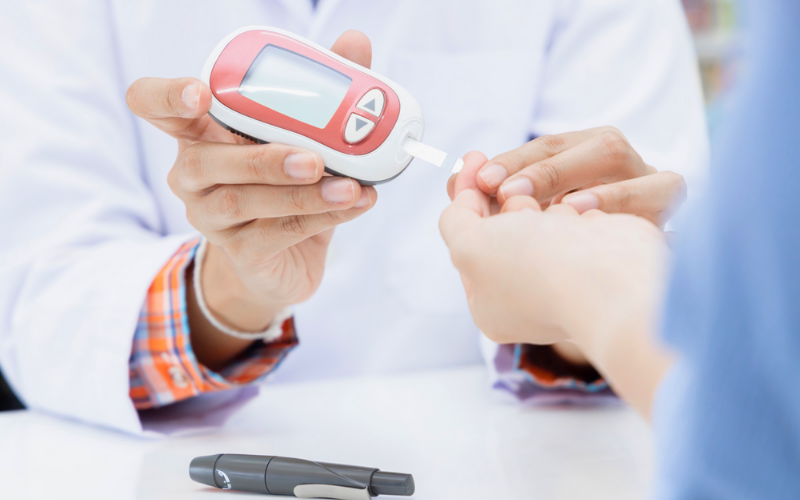India is the diabetes capital of the world, with over 77 million people formally diagnosed with high blood sugar. Lifestyle changes coupled with a higher genetic predisposition have contributed to increased instances of insulin resistance at an early age. Did you know South Asians are up to 4 times more likely to develop Type 2 diabetes than their white European counterparts? Read on to learn more about high blood sugar treatment, including the side effects of long-term medication and tips to manage high blood sugar effectively.
What Levels of Blood Sugar are Considered Diabetic?
In normal adults without diabetes, fasting sugar levels range from 70 mg/dl to 100 mg/dl and sugar levels 2 hours after meals range from 90 mg/dl to 100 mg/dl. However, sometimes sugar levels fluctuate even among healthy individuals depending on various factors, including the type of food consumed, quantity of food, alcohol consumption, stress, and dehydration. However, a fasting blood sugar level from 100 mg/dl to 125 mg/dl is prediabetes. Anywhere higher than 125> mg/dl is a sign of diabetes. Similarly, if in a post-prandial test, sugar levels of 200 mg/dl or more indicate diabetes. If you have a blood sugar level of 200 mg/dl in a random blood sugar test, you will likely have diabetes. This is especially true if you have been experiencing signs of prediabetes like frequent urination, fatigue, extreme thirst, etc.
Also, recommended sugar levels of diabetics vary depending on age. For instance, teenagers with diabetes must have recommended fasting blood sugar levels of 70 mg/dl to 150 mg/dl after fasting, while in adults, it must range from 70 mg/dl to 100 mg/dl. Blood sugar levels above 250 mg/dl are very high and require immediate medical attention. Some common blood tests for diabetes include – Hemaglobin A1C or HbA1c test, Random Blood Sugar Test, Fasting Blood Sugar Test, Two–Hour Postprandial Test, and Oral Glucose Tolerance Test.
High Blood Sugar Treatment Options
If you are diagnosed with high blood sugar, treatment would involve a combination of medication, dietary changes, stress management, physical activity, and regular monitoring. In instances where sugar levels are dangerously high, emergency treatment could include a combination of fluid replacement, electrolyte replacement, and insulin therapy. We’ll look into each of these high blood sugar treatment options in detail:
- Medication: In India, physicians prescribe medicines while simultaneously advising patients about maintaining diet and physical activity because they know patients seldom listing to the latter. Medications for type 2 diabetes work by lowering glucose production and improving the body’s sensitivity to insulin. Some possible side effects of blood sugar medication include nausea, bloating, and diarrhoea. Sometimes, doctors prescribe a combination of drugs, including blood pressure and cholesterol-reducing medicines.
- Dietary Modifications: Earlier, doctors recommended eating chapatis and avoiding rice – common sense being that since we’re adapted to eating rice, chapatis would be less pleasant, encouraging people to eat less. This is, however, not the norm anymore. Instead, they now recommend portion control, less snacking, monitoring carbohydrate intake, eating a fibre-rich diet, staying hydrated, and choosing foods like whole beans, dal, ragi, green vegetables etc., that have a low glycemic index.
- Increasing Physical Activity: Recommending exercise to manage diabetes isn’t new. More than 2000 years ago, Charaka, the ancient Indian saint-physician, suggested physical activity to treat diabetes. Regular exercise helps control glucose levels and improves insulin sensitivity. While we don’t recommend hitting the gym for heavy-duty exercising without consulting your doctor, you can always walk, swim, take the stairs, etc., to stay active. Also, do not sit before the computer for a long time – you must take a break regularly, taking a few minutes to walk or stand every 30 minutes.
- Weight Loss: Losing weight helps control glucose levels and increases insulin insensitivity. It also lowers blood pressure and improves lipid profile. In fact, losing even as much as 5% of your body weight can significantly improve your health.
- Regular Monitoring: The doctor may recommend checking your blood sugar levels regularly to ensure it remains within the targeted levels. You can buy a blood glucose metre and note the measurements.

Emergency High Blood Sugar Treatment Options
Diabetic ketoacidosis is a serious complication of hyperglycemia. The body secrets excess blood acids or ketones because it cannot produce enough insulin to convert blood sugar into energy. In such a situation, the physician may prescribe:
- Fluid Replacement: Normal saline is administered to replace fluids lost through urination and dilute the extra blood sugar.
- Electrolyte Replacement: Patients are administered insulin to replace electrolytes to keep the nerve cells and the heart to ensure they work properly.
- Insulin Therapy: Insulin helps reverse the process that causes ketones to build up in your blood.
High Blood Sugar Treatment Side Effects
While diabetes can be managed through a combination of lifestyle changes and medication, the latter could cause nausea, diarrhoea, abdominal pain, and liver inflammation. But the consequences of unchecked diabetes can be much more severe than any high blood sugar treatment side effects.
Living With High Blood Sugar
High blood sugar or hyperglycemia can affect people with Type 1 and Type 2 diabetes, leading to serious health issues if left untreated. The doctor will advise you to take your sugar levels seriously and monitor them to avoid recurrence. You’ll also be asked to take a blood or urine test to know ketone levels. You must first consult a sugar specialist doctor in Nagercoil, working with them to change your diet and lifestyle.
Visit us if you are looking for a high blood sugar treatment hospital in Nagercoil.
